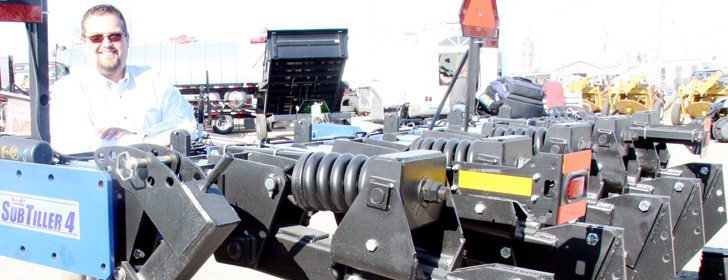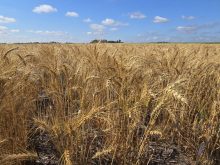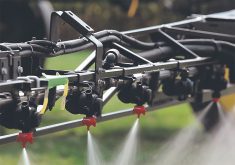FARGO, N.D. — The old myth about the freeze-thaw cycle breaking up hardpan is just that, according to researchers.
“People used to believe there’s no soil compaction on the Prairies because of our cold winters, but that’s not true,” said Todd Botterill of Botterill Sales in Newton, Man.
“Penn State studied compaction all around the world. They found that it takes five years to break up a compaction layer at a depth of 10 inches, assuming there is absolutely no traffic on that field.
Read Also

Fusarium head blight mycotoxin detector in the works
A PhD student at the University of Saskatchewan has been working on developing a method of detecting fusarium damaged kernels to ease the struggles of producers, agronomists and industry.
“It takes 10 years of the freeze-thaw cycle to break up compaction at 10 to 20 inches, again with no traffic. At 20 inches and deeper, no amount of freeze-thaw can break up the compaction.”
Botterill said winter may have broken up some of the hardpan when farm implements were smaller and lighter, but the weight of modern implements has reached the point that frost is no longer a mitigating factor.
“You are going to create compaction with 50,000 pound tractors, 40,000 lb. combines, 900 bushel grain carts, B trains in the field and 700 bu. air carts with 90 foot drills. You can’t avoid it,” he said.
“Heavy machinery squeezes the air pockets out of the soil. Basically, the pockets collapse. They no longer hold air or water. If there’s water in the pockets going into winter, it will freeze and expand and break up some hardpan. But the heavy machinery we have now destroys the pockets. Frost can’t do its job. The compaction remains.”
Botterill said the dense compaction may be as shallow as six inches, but it’s hard nonetheless.
“That’s why we’re seeing so many zero till guys in Western Canada having trouble lately getting their drills in the ground. It’s compaction close to the surface,” he said.
“They run their drills at the same seeding depth year after year. They’re creating the same situation we had back in the days of the mouldboard plow. It wasn’t the plow itself that created the plow pan years ago.”
Botterill thinks every farmer should own a penetrometer to identify their compaction locations and depths. A three-foot-deep hole may take more time than a penetrometer, but it’s a better way to study hardpan.
“I dug some three foot holes with a farmer in Manitoba not too long ago. We found hardpan at 14 inches in one area and 22 inches in another area.”
In a field two miles away there was no compaction.
“So if you’re going to take some sort of remedial action, you’d better know where the hardpan is located.”
Botterill Sales recently took on three new lines of American-built tillage equipment designed for soil conditions on the Great Plains: The Blu-Jet Sub Tiller 4 is a ripper from Nebraska, the Landoll VTPlus is a vertical tillage machine from Kansas and the Smart-Till ST203 is an aerator from Kansas.
The Blu-Jet Sub Tiller comes equipped from the factory with a penetrometer.
“A ripper without a penetrometer is like a car without a steering wheel,” said Botterill.
Most manufacturers of in-line rippers employ a sweep at the bottom to lift the soil.
“The problem with a sweep is that it creates a smear just below the depth it runs. That smear becomes your new hard surface,” he said.
“So you think you’re breaking up a hardpan layer, but really, you’re creating a new one.”
Blu-Jet uses a narrow shank 1.25 inches wide, with a long sharp point.
“It’s mounted at a radical angle so the shank is what actually lifts the soil.”
The shank and point fracture the soil up to 20 inches left and right as they slice through the soil profile.
The shanks are mounted on 30-inch centres, so each tool fractures compaction in a 40-inch swath and provides a 10-inch overlap.
Most rippers rely on the point to do the work, but Botterill said the Blu-Jet design has the shank doing the heavy work. The point just leads the way.
He said that’s why Blu-Jet tips last longer. As well, the massive, high carbon shank is six inches deep and built to take the abuse.
“It’s a big heavy shank. It’s designed to hit stones and rocks and not break. It should last for decades,” he said.
“The SubTiller 4 doesn’t need any down pressure. It sucks itself into the ground because of the angle of the shanks. The shanks have a 3,000 lb. trip force, so they’re definitely de-signed to stay in the ground.”
The double frame is seven inches by seven inches, with 39-inch ground clearance. Rippled 20-inch coulters are designed to swivel as they slice through tough material such as BT corn residue.
Botterill said farmers typically find their compaction layer at 10 to 12 inches. Although SubTiller 4 is designed to run as deep as 18 inches, Blu-Jet recommends finding the hardpan with a penetrometer and then running the machine about one inch below that depth.
“If you run deeper, you’re just wasting fuel,” he said.
“The other thing you should think about is that running deeper than necessary actually pushes the hardpan layer down. If you push the hardpan so deep that you can’t reach it, then you’re in real trouble.
“Any kind of ripper should be run in a rotation, never in consecutive years. Once every four years in clay; once every six years in lighter soil.”
He said the ripper may be used more often in highly compacted high traffic areas.
Botterill advised farmers to continually change the depth, no matter what kind of tillage tool they use. Running over the same piece of ground twice without changing the depth creates a new hardpan layer.
“Speed should be 4.5 to 5 m.p.h. That’s what creates the shock and shatter in the soil.”
A seven shank pull-type SubTiller 4 retails for about $32,000 US.
The Landoll VTPlus looks like a tandem disc machine at first glance, but a study of the geometry shows that the angle of the gangs has been reduced to 10 degrees.
“That’s what changes it into a vertical tillage machine,” said Botterill.
“The VTPlus has a new frame and new shallow concave discs so it buries less residue. With a tandem disc, you bury most of your residue down at the depth you’re working, but the VTPlus anchors most of the residue close to the surface. That’s where the soil organisms are and that’s where the oxygen is, so your residue breaks down faster.”
The 22-inch diameter discs have a shallow 1.5-inch concave to accommodate mud scrapers. They are mounted on seven-inch centres on the front and rear gangs.
Botterill said there’s no way to put scrapers on rippled blades. As a result, they plug up solid in wet soil.
“That’s why mud isn’t as much of a concern with the VTPlus as it is with other vertical units on the market,” Botterill said.
“Guys want to see some black dirt in the fall so the soil warms quicker in the spring. And they want to get rid of wheel tracks too, all in the same single pass. The shallow concave discs have more sideways dirt movement to fill wheel ruts. And the rolling baskets at the back firm up the soil and anchor the residue.”
Down pressure is provided by springs and is manually adjustable with a single crank handle. Fore/aft levelling is adjusted hydraulically to tune the machine for different field conditions.
The machine uses self-aligning trunnion bearings. The cushioned gang hangers flex to meet the needs, which requires it to realign itself. The bearings have triple lip seals and cannot be damaged by over-greasing.
Botterill said the 33-foot unit rides on four 16.5 inch tires, four inches wider than tires found on other vertical tillage machines. It also has two tires on each wing.
The five-section 49-foot machine has walking tandem dual semi tires and walking tandems on the wings for better flotation.
The 33 foot VTPlus carries a list price of $77,000.
The tines on the Smart-Till aerator are capable of cutting holes in the soil as deep as eight inches, allowing the soil better access to air and water. The tine gang angle is adjustable in 2.5 degree increments from zero degrees to 10 degrees.
“At the full 10 degree angle, I think it rips up the soil more than you want,” Botterill said. “It acts more like a roto tiller. Most guys find five degrees is about right. I’ve found five degrees gives better water infiltration than the other settings.”
The spikes are eight inches long and can be set to fracture soil at the full eight-inch depth or for shallow surface work rejuvenating hayland and pasture. They cause little surface disturbance at any depth.
The optional rotary harrows at the back chop residue and smooth and level the surface. They can be adjusted from 30 degrees forward to 30 degrees reversed.
“We had the Smart-Till aerator at a field day,” Botterill said. “It was dry, hard soil. The other machines couldn’t get themselves into the ground to work. They just bounced along on the surface. The Smart-Till dug itself straight down into the soil to the eight inch depth and went right to work.”
The 30 foot Smart-Till aerator retails for $73,000.
For more information, phone Todd Botterill at 204-871-5004 or visit Blu-Jet at www.thurstonmfgco.com, Landoll at www.landoll.com and Smart-Till at www.hccincorporated.com.
















